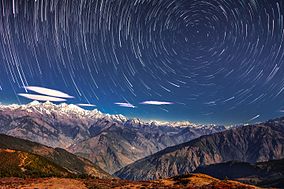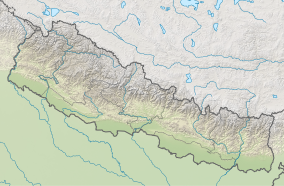| Langtang National Park | |
|---|---|
| Nepali: लाङटाङ राष्ट्रिय निकुञ्ज | |
 Langtang National Park | |
| Location | Nepal |
| Nearest city | Kathmandu |
| Coordinates | 28°10′26″N 85°33′11″E / 28.1738°N 85.5531°E |
| Area | 1,710 km2 (660 sq mi) |
| Established | 1976 |
| Governing body | Department of National Parks and Wildlife Conservation |
Langtang National Park is a national park in north-central Nepal. It was established in 1976 as Nepal's first Himalayan national park and the country's fourth protected area. It covers an area of 1,710 km2 (660 sq mi) in the Nuwakot, Rasuwa and Sindhulpalchok Districts of the central Himalayan region. It contains 26 village communities and includes the Langtang valley. In the north and east it is linked with Qomolangma National Nature Preserve in the Tibet Autonomous Region.[1] The eastern and western boundaries follow the Bhote Koshi and the Trishuli river, respectively.[2]
The Gosainkunda lake is located at an elevation of 4,300 m (14,100 ft) inside the park. The Dorje Lakpa range at 6,988 m (22,927 ft) bisects the park from west–east to south–east. The summit of Langtang Lirung is the highest point in the park at 7,245 m (23,770 ft).[3]
Langtang National Park is part of the Sacred Himalayan Landscape.[4]
- ^ Bhuju, U. R.; Shakya, P. R.; Basnet, T. B. & Shrestha, S. (2007). Nepal Biodiversity Resource Book. Protected Areas, Ramsar Sites, and World Heritage Sites. Kathmandu: International Centre for Integrated Mountain Development, Ministry of Environment, Science and Technology, in cooperation with United Nations Environment Programme, Regional Office for Asia and the Pacific. ISBN 978-92-9115-033-5.
- ^ Yonzon, P.; Jones, R.; Fox, J. (1991). "Geographic Information Systems for Assessing Habitat and Estimating Population of Red Pandas in Langtang National Park, Nepal". Ambio. 20 (7): 285–288.
- ^ Mishra, P. N. (2003). "The Langtang National Park: a proposed first Biosphere Reserve in Nepal". Journal of the National Science Foundation of Sri Lanka. 31 (1&2): 333–335.
- ^ Gurung, C. P.; Maskey, T. M.; Poudel, N.; Lama, Y.; Wagley, M. P.; Manandhar, A.; Khaling, S.; Thapa, G.; Thapa, S.; Wikramanayake, E. D. (2006). "The Sacred Himalayan Landscape: Conceptualizing, Visioning, and Planning for Conservation of Biodiversity, Culture and Livelihoods in the Eastern Himalaya" (PDF). In McNeely, J. A.; McCarthy, T. M.; Smith, A.; Whittaker, O. L.; Wikramanayake, E. D. (eds.). Conservation Biology in Asia. Kathmandu: Nepal Society for Conservation Biology, Asia Section and Resources Himalaya Foundation. pp. 10–20. ISBN 99946-996-9-5.
